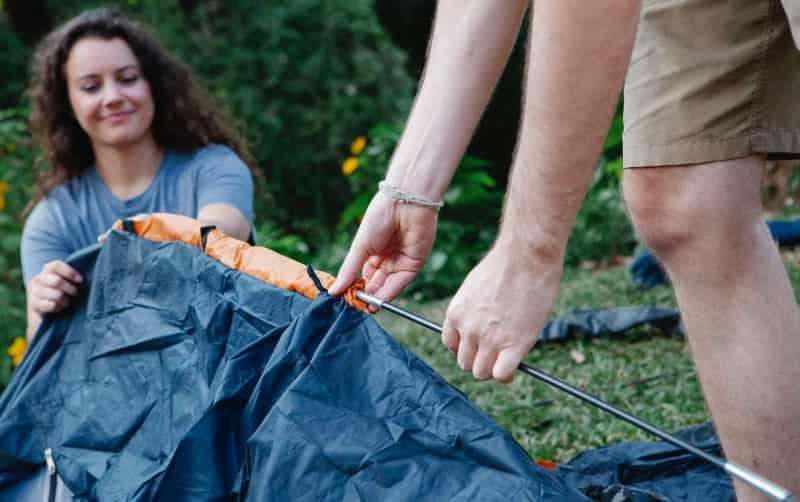How to pitch a tent
If you’re just starting out in your camping adventures, the prospect of learning to put up a tent successfully can seem daunting – but, like many key skills, it’s easy when you know how.
It’s vital to put your tent up properly so you can have a good night’s sleep and protect yourself against the weather. This guide is here to help you learn how to pitch a tent, with step-by-step instructions and some handy tips to cover different situations.

What you’ll need to pitch a tent
Before you start to pitch your tent, check to make sure you’ve got all the pieces and tools you’ll need. These include:
-
A groundsheet
-
A footprint or piece of tarp*
-
A tent
-
Tent poles
-
Pegs or stakes
-
A rain fly
-
A mallet or rock*
*Optional, depending on the model of your tent
How to pitch a tent in 8 easy steps
Once you’ve checked all your equipment, you’re ready to put your tent up. There are several elements to any tent, and learning to pitch one properly is simply a question of knowing the correct order to set things up. Here’s our step-by-step guide to pitching a tent perfectly.
1. Pick a place to pitch
Before you start pitching your tent, you need to choose where to put it. You’ll want plenty of room for your guy lines, so make sure there’s at least three metres between your site and any obstacles. Place the side of the tent with the strongest pole structure facing any wind.
When camping in hot weather, angling the door towards the breeze helps to cool down your tent’s interior.
For more tips on picking a pitch, see the ‘How to pick a pitch for your tent’ section below.
2. Lay your groundsheet
Brush away any twigs, stones or other debris from your pitching area, then put your groundsheet down. If you have a tent footprint or an extra section of protective tarp, place this down first.
Put your tent on top of the groundsheet, facing upwards. Plug pegs loosely into all four corners of the tent to ensure everything stays secure for the moment.
3. Sort out the flysheet
Take a look at the instructions and see if it tells you to get the flysheet or inner up first, then tackle this part of the job. Some tents have attached inner and outer layers, which speeds the task up.
If it's a flysheet-second option, place the tent’s interior on top of the groundsheet, matching both sections of material corner to corner. Make sure your doorway is facing exactly where you want.
4. Connect your poles
Next step is to connect your tent’s poles. Fix them together first, inserting each adjacent pole with care. Don't just let them spring into place, as this can cause damage.
5. Attach the poles to the frame
There are typically two ways in which your tent’s internal body will attach to the poles: sleeves or clips. Thread the poles through the sleeves or clip the material to the frame, beginning in one corner before moving on to the opposite corner.
Don’t pull the poles through the sleeves – if they’re joined up by elastic or bungee cords, this will pull them apart and you’ll have to start all over again. It's best to push the poles instead.
6. Set up the tent
Next, attach the poles to the pin and grommet (or ring and pin) found at each of the four corners of your tent's inner body. This can require a little force as the whole structure needs a certain level of tension to stand upright.
To avoid breakages, bend the frame carefully instead of putting pressure on individual poles. Then, if it’s separate from the tent body, add the flysheet – making sure to match up the inner doorway with the flysheet's entrance.
Some tents use velcro to affix the rain fly to the poles; others include bungee cords that stretch the cover overhead and then connect underneath the poles. Have a look at the instructions to be certain which applies to your tent.
7. Peg the tent in properly
One of your final tasks is to stake everything down securely. Push your pegs into the ground at a 45-degree angle – with the hook pointing away from the tent – then hammer them in with a mallet or rock if the ground is hard. Avoid stamping on the stakes with your foot as this risks injury and breakages.
Using the right tent pegs is vital – to check, read our guide to all the different kinds of tent pegs.
8. Finish up
Once your tent is up, pull the poles as far apart as possible to make sure the material is nice and rigid. This gives you maximum room overhead and also means that rain will stream down the flysheet and away from the roof. Tying your guy lines properly also helps prevent water from pooling above you. To check the tension of the tent, make sure that the seams on the fly align with the seams of the tent body and its poles.

Handy tips for pitching a tent
To make life even easier, here are a few more useful pointers to smooth the process a little more.
-
If you have an air or pop-up tent, many of the rules for setting up your tent will differ. This guide is for traditional pole tents.
-
After checking our step-by-step instructions above, it’s still worth reading your tent's user manual, as there may be a few key differences.
-
Take a photo of the key details in the manual in case you lose it or forget to bring it.
-
Do a practice pitch in your garden before your holiday. As well as helping you learn how to put up a tent, this also helps troubleshoot any problems and check for missing equipment.
-
Try to arrive at your campsite before dark so you can pitch in the daylight.
-
Follow our camping checklist to confirm you have all the right equipment before you set off.
-
Ask for help – it’s much quicker and easier to put up a tent between two or three people, rather than just one.
-
Pack extra pegs in case yours get bent during the set-up process.
How to pitch a tent on your own
Pitching a tent is easiest when you’ve got at least two people, but it can certainly be done alone. Here are a few tips for pitching a tent when you’re on your own.
-
Consider buying a pop-up tent if you do a lot of solo camping, as these are much easier to set up alone.
-
Place something heavy – perhaps a stone – on each corner of the tent after you lay it out on the ground to stop it from catching the wind.
-
For extra ease, leave just enough of the peg exposed to let you slip a guyline over it easily.
-
Even if the weather seems fine, it's worth using all the guy ropes and peg points – the wind can gust up at any time, and it's harder to fix this alone.
How to choose a pitch for your tent
Before you start actually putting your tent up, you need to choose a suitable location for it. Here are a few tips for deciding where to pitch your tent.
-
The ideal tent pitch is on completely flat and level ground, free from tree roots, rocks, lumps or dents that could be uncomfortable as a base
-
Don’t pitch your tent too close to trees or any other plants that might drop bits on you through the night. Instead, block out wind by pitching near a bush or hedge (or using your car as a windbreak).
-
If a sloping pitch is your only option, make sure your head is at the top of the slope and feet at the bottom when lying down. This will help stop you from rolling out of bed at night.
-
If it’s raining, pick a spot where the ground isn’t waterlogged. Avoid ditches and other concave patches of land, as these collect puddles. Try to pitch on higher ground, which tends to be drier.
-
Choosing the orientation of your tent will depend on the climate – if it’s warm, face the door towards the wind for a cooling breeze inside; if it’s windy, angle the side with the strongest pole structure towards the wind so it will stay solid.
How to pitch a tent in the rain
When you’re staying outdoors there’s always the possibility of having to cope with some rain or wind. Camping in bad weather doesn’t have to ruin your break – you just need to know how to pitch a tent in the rain. Here are some tips to get you started:
-
Use your car for shelter while pitching your tent – it makes a great wind breaker.
-
Set up a tarp to place your tent elements under to keep them dry – then just bring them out as you need them.
-
Bring waterproofs to wear while putting up the tent, then pop them in a plastic bag as soon as you’re indoors and dry.
-
Put the flysheet up first if you can, instead of the inner body, so you have a certain level of protection while pitching.
-
Don’t skip the pegs and guy ropes. While it’s tempting to get inside as soon as possible, it’s essential that your tent is fully stable when camping in bad weather.
-
Get into the habit of keeping your tent entrance closed when packing it away so it won’t be open to the elements when you get it out again.
-
Practise your tent setup at home so the process is as quick as it can be when you’re on site.
For more in-depth advice on how to cope with bad weather while camping, read our guides to pitching a tent in the rain, camping in high winds and camping in a storm to give you tips on how to stay safe and comfortable.
If you follow all the advice given above, pitching your tent should be nice and straightforward – even in some tricky circumstances. Happy pitching!
FAQs: Pitching a tent
Is pitching a tent hard?
Pitching a tent is not difficult at all – especially with modern designs that have built-in features like snap-together poles. Like many things in life, it just needs a little bit of practice and preparation.
There are a few other things that can help here too, such as making sure you arrive at your campsite in time to pitch in daylight, and practising your setup at home so you’ve got a headstart on what to do (and checked that you’ve got all the right bits you need).
What are the easiest tents to set up?
Pop-up tents are the easiest design to use – just take it out of the bag and it will ‘pop’ into shape ready for you to peg down. They’re often quite small though, so if you need something larger, look for a fast-pitch tent, which are similarly easy to use.
Can you set up a tent by yourself?
Smaller tents, especially fast-pitch models, can easily be set up by one person. For larger models, an extra person is useful for key stages like pegging down the groundsheet. If you’re on a family holiday, get the children involved – they’ll love the sense of adventure and learn some handy skills too.




